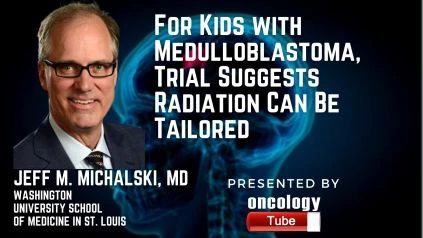Jeff M. Michalski, MD, MBA, FASTRO, Professor of Radiation Oncology at Washington University and the Siteman Cancer Center speaks about For Kids with Medulloblastoma, Trial Suggests Radiation Can Be Tailored.
Link to Article:
https://www.cancer.gov/news-events/cancer-currents-blog/2021/medulloblastoma-low-dose-volume-radiation
A one-size-fits-all strategy to radiation therapy for children and young people with medulloblastoma, a form of fast-growing brain cancer, may eventually be phased out. According to the findings of a big clinical research, some children can safely receive lower doses of radiation without compromising their long-term survival, while others may require the usual amounts.
Although conventional therapies heal more than 80% of children with average-risk medulloblastoma, radiation can harm their growing brains for the rest of their lives. Speech, learning, hearing, and hormone functioning are among the long-term consequences.
According to study findings published in the Journal of Clinical Oncology on June 10, delivering radiation to a smaller area of the brain around the tumor was as effective as delivering radiation to a wider area. However, a lower radiation dose did not treat the cancer as well as the usual amount. These patterns, on the other hand, were more nuanced among individuals whose tumors had specific genetic characteristics.
According to Jeffrey Buchsbaum, M.D., Ph.D., of the National Cancer Institute’s Radiation Research Program, who was not involved in the study, “the study heralds in an age of precision medicine in radiation for youngsters and young adults with medulloblastoma.” Precision medicine is a therapeutic method that is adapted to the genetic characteristics of a patient’s cancer.
Medulloblastoma and Radiation
When a kid is diagnosed with medulloblastoma, the cancer is classified as low, average, or high risk, depending on how aggressive the disease is and if it has progressed beyond the brain’s initial site.
Surgery to remove as much of the tumor as feasible is usually followed by chemotherapy and several weeks of radiation for children with average-risk medulloblastoma. This involves radiation to the entire brain and spine, as well as a boost to the cerebellum and brain stem, which is where medulloblastoma cancers begin to form.
The study team examined a lower dose and a smaller region, or volume, of radiation, based on promising results from smaller trials. “Might those two things—reducing the dosage and the volume—lead to improved cognitive results for the children?†Dr. Michalski wondered.
The study included 549 children ages 3 to 21 with average-risk medulloblastoma from six countries. Participants underwent a battery of hearing and IQ tests as part of the research, which monitored patients’ progress for a median of 9 years.
Basic research investigations offered “a greater knowledge of the biology of medulloblastoma†many years after the study began, leading to a change in the way the cancer is identified, according to Dr. Michalski. Doctors now classify medulloblastoma into one of four subtypes based on genetic alterations in patients’ tumors, according to this new knowledge.
So the researchers looked at the study data through the prism of those four subtypes, analyzing the genetic characteristics of the individuals’ tumors.

